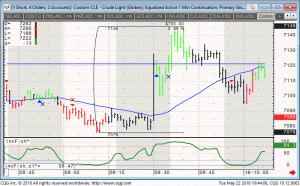Futures Options Writing
Have you ever wondered who sells the futures options that most people buy? These people are known as the option writers/sellers. Their sole objective is to collect the premium paid by the option buyer. Option writing can also be used for hedging purposes and reducing risk. An option writer has the exact opposite to gain as the option buyer. The writer has unlimited risk and a limited profit potential, which is the premium of the option minus commissions. When writing naked futures options your risk is unlimited, without the use of stops. This is why we recommend exiting positions once a market trades through an area you perceived as strong support or resistance. So why would anyone want to write an option? Here are a few reasons:
- Most futures options expire worthless and out of the money. Therefore, the option writer is collecting the premium the option buyer paid.
- There are three things that happen to the underlying price of the option: Price goes up, goes down or stays the same. If when the option expires, the market price was at or below your strike price you collect all the premium if two of those things happen Time decay is the option writer’s friend.
- The writer believes the futures contract will not reach a certain strike price by the expiration date of the option. This is known as naked option selling.
- To hedge against a futures position. For example: someone who goes long cocoa at 850 can write a 900 strike price call option with about one month of time until option expiration. This allows you to collect the premium of the call option if cocoa settles below 900, based on option expiration. It also allows you to make a profit on the actual futures contract between 851 and 900. This strategy also lowers your margin on the trade, and should cocoa continue lower to 800, you at least collect some premium on the option you wrote. Risk lies if cocoa continues to decline, because you only collect a certain amount of premium and the futures contract has unlimited risk the lower it goes. So you should trade with a stop on the futures contract. You can read on different strategies using options on futures here:
https://www.cannontrading.com/tools/education-futures-options-trading-101
Cannon offers SPAN margins for options sellers.
Many brokers will restrict or increase the margins required for options sellers, or traders who like to “collect premium”, but here at Cannon we can find you the best set up utilizing the multiple clearing arrangements we have with more than a few FCMs.
How much margin is required to sell a futures option?
That is a question we get asked often. The exact number is an output of SPAN margins. SPAN deserves a post on its own, but what it stands for is: Standard Portfolio Analysis of Risk. The formula takes into consideration volatility, time value, distance of strike price from current underlying future, and more.
Outright options may be easier to “guesstimate” margin than more complex strategies and spreads, but our free platform, E-Futures Int’l (https://www.cannontrading.com/software/e-futures-international )has a margin calculator built in so you can calculate the margin you will need for different strategies.
Commission for selling options on futures?
Commissions will vary based on the following:
Are you trading online or with a broker?
Trading volume
Account size
Risk responsibility.
The rates for selling options will vary from as low as $0.25 per side + fees for HIGH VOLUME, institutional accounts to $30 per side + fees for retail, broker assisted accounts.
Selling options is NOT for newcomers as it involves higher risk than buying options.
However, selling options and trading option spreads may offer an edge if done with proper risk management. No guarantees are made here.
Our strength at Cannon is our ability to offer CUSTOMIZED trading solutions, so contact a broker at:
https://www.cannontrading.com/company/contact
and learn more about risks and opportunities in futures trading (https://www.cannontrading.com/riskopportunity), what software you can use, consult with a broker on margin, commissions and strategy questions and much more!
Trading Futures, Options on Futures, and retail off-exchange foreign currency transactions involves substantial risk of loss and is not suitable for all investors. You should carefully consider whether trading is suitable for you in light of your circumstances, knowledge, and financial resources. You may lose all or more of your initial investment. Opinions, market data, and recommendations are subject to change at any time.










